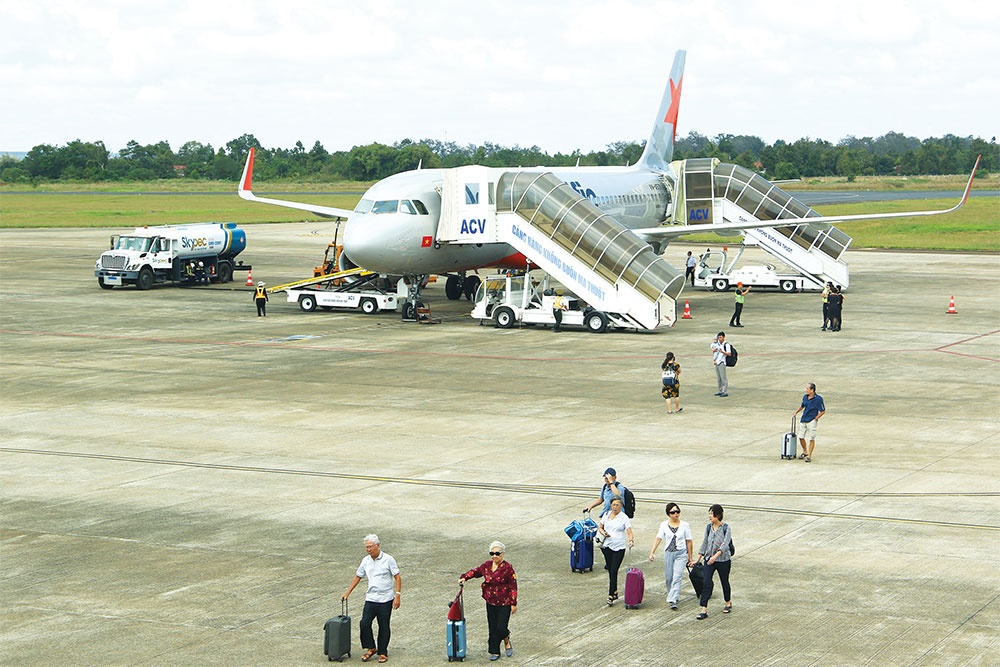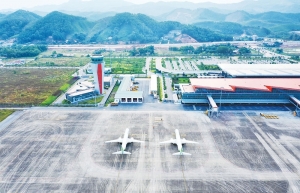Bolstering nation’s economy through network in the skies
Vietnam has ample potential for tourism development as the country boasts a long coastline, beautiful landscapes, and abundant natural resources. Located in a strategic position, Vietnam is an important link in the global supply chain. To unlock the country’s full potential, it is vital to promote the development of infrastructure, especially aviation infrastructure.
 |
| Some of Vietnam’s small airports have seen a huge rise in passenger numbers, Photo: Le Toan |
The fact is that the aviation structure has yet to be fully developed in some areas. Provinces in the north-west region are known for their magnificent scenery and cool climate, which is ideal for ecotourism, adventurous travel, and luxury hospitality. Beside tourism, the provinces can focus on the processing and export of agricultural and forestry products as well as the making of handicrafts. However, the localities fail to take advantage of their strengths due to a lack of infrastructure facilities like airports.
Likewise, the Central Highlands have the potential to develop eco-tourism, agricultural, and forestry sectors. Despite its strategic location in terms of economics and national security, the region has limited connectivity, which complicates trade flows.
Recognising the importance of aviation infrastructure, some localities have proposed the construction of small airports to serve passenger and cargo transport, which will help promote the local tourism industry and exports of agricultural products. At the same time, the proposed airports are expected to be a driving force for the local economy by improving connectivity.
Recently, in an official dispatch to the prime minister and the Ministry of Transport (MoT), chairman of Ha Giang People’s Committee proposed to include Tan Quang Airport in the master plan for the development of airports in the 2021-2030 period with a vision to 2050. The master plan is being reviewed and finalised by the MoT.
Ha Giang People’s Committee noted that the province boasts favourable conditions to develop citrus fruit trees, afforestation, tourism, and a border gate economy. Some popular tourist attractions in the locality include Dong Van Karst Plateau Geopark and the national heritage terraced rice fields in Hoang Su Phi.
However, due to its location and terrain, Ha Giang can only currently be accessed via road, with the two-lane National Highway No.2 connecting with Hanoi and other provinces. The downtown area is 260km from Noi Bai International Airport.
The provincial leaders stressed that it is crucial to include Tan Quang Airport in the master plan and call for private investors.
At the meeting with Deputy Prime Minister Le Van Thanh, the leaders of 15 cities and provinces emphasised the importance of developing new airports to meet the rising demand for air travel in their localities.
New airports have been proven to catalyse the economic growth of certain localities in Vietnam. For example, Phu Quoc, which was once a poor island district. Despite its prime location and proximity to other regional countries, Phu Quoc was previously underdeveloped and had only ocean transportation. However, Phu Quoc has now become Vietnam’s first island city with a vision to become Asia’s leading economic and tourism centre.
According to local authorities, Phu Quoc only welcomed 300,000 tourist arrivals in 2010. In 2014, this figure had doubled to 600,000, including 125,000 international tourists, up 21.5 per cent year-on-year. The island city has earned $91.91 million in revenue from tourism, up 84 per cent from 2018. The increase is driven by the launch of Phu Quoc International Airport in 2012.
Since the airport was put into operation, a growing number of large investors have flocked to Phu Quoc to develop hotels and resorts, transforming the island into a tourist destination in the region.
Vietnam still has many provinces with ample potential for tourism development, such as in the north-west and Central Highlands regions.
The provinces have not only beautiful sceneries to promote the tourism sector but also favourable conditions to develop industries.
Nguyen Tien Dat, CEO of AZA Travel, said that it is suitable to build new airports in these regions, where aviation infrastructure remains limited. “Tourists living in the south prefer travelling to the north, like Ha Giang. However, it is quite challenging to travel by road to this province. If there is a direct flight from Ho Chi Minh City to Ha Giang, it will be more convenient for tourists from the south,” Dat said. “The airport development in Ha Giang will have a positive impact on tourism, thereby contributing to the local socioeconomic development,” he stressed.
Other leaders of travel agencies believe that the comprehensive development of transport infrastructure is vital to boost tourism and the economy in the provinces. Despite some upgrades in the road system, the provinces are still hard to reach due to the mountainous terrain.
 | Finding suitable models for small airports in Vietnam Michel Werson, chief economist and lead of Financial Advisory at NACO – a subsidiary of Royal HaskoningDHV – delves into the ins and outs of airport development. |
 | Utilising national advantages with crucial infrastructure Small airports and dual-use airports are expected to be valuable infrastructure fulcrums for many remote localities to attract investment and exploit the advantages of tourism, if selected and added to the plan and early investment implementation. |
 | Making the right choices for private airport expansion Vietnam’s airport development plan for 2030 is a hot issue, attracting much interest among private investors and cities and provinces. Tony Foster, managing partner at Freshfields Bruckhaus Deringer LLP, delves into future opportunities, possible risks, and lessons from other countries. |
What the stars mean:
★ Poor ★ ★ Promising ★★★ Good ★★★★ Very good ★★★★★ Exceptional
Related Contents
Latest News
More News
- Vietjet launches daily Manila flights to celebrate year-end festive peak season (December 05, 2025 | 13:47)
- The destinations powering Vietnam’s festive season travel demand (December 04, 2025 | 18:33)
- Vietnam named among the world’s most exciting winter destinations (December 04, 2025 | 15:10)
- Phu Tho emerges as northern Vietnam’s new tourism hub (December 01, 2025 | 17:00)
- Vietjet completes Airbus A320/A321 updates ahead of deadline (December 01, 2025 | 09:49)
- Vietjet resumes Con Dao flights from early December (November 28, 2025 | 15:24)
- Free tickets, Lunar New Year promotions on offer at Vietjet Mega Livestream (November 26, 2025 | 15:32)
- Scandinavian Airlines and Vietnam Airlines broaden agreement with new routes (November 25, 2025 | 17:04)
- Halong Cruise Port welcomes over 3,100 international visitors (November 12, 2025 | 18:06)
- Vietnam.travel climbs to second place in Southeast Asia website rankings (November 12, 2025 | 18:01)

 Tag:
Tag:



















 Mobile Version
Mobile Version